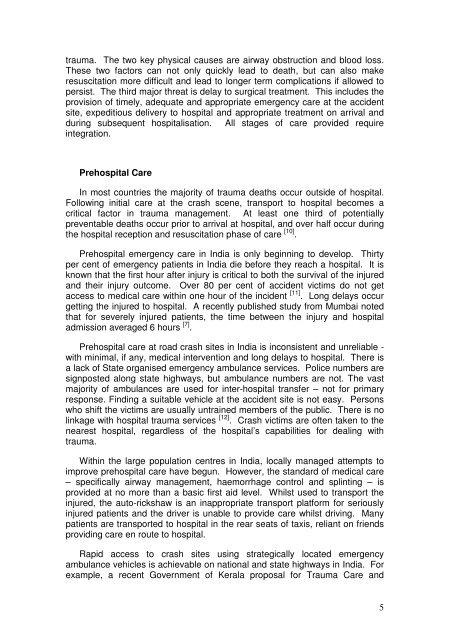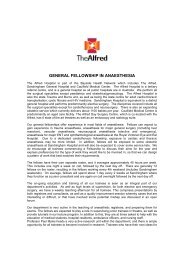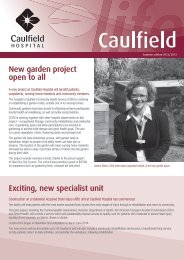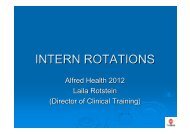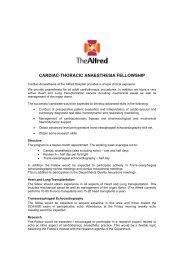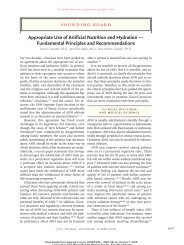India and the Management of Road Crashes ... - Alfred Hospital
India and the Management of Road Crashes ... - Alfred Hospital
India and the Management of Road Crashes ... - Alfred Hospital
- No tags were found...
Create successful ePaper yourself
Turn your PDF publications into a flip-book with our unique Google optimized e-Paper software.
trauma. The two key physical causes are airway obstruction <strong>and</strong> blood loss.These two factors can not only quickly lead to death, but can also makeresuscitation more difficult <strong>and</strong> lead to longer term complications if allowed topersist. The third major threat is delay to surgical treatment. This includes <strong>the</strong>provision <strong>of</strong> timely, adequate <strong>and</strong> appropriate emergency care at <strong>the</strong> accidentsite, expeditious delivery to hospital <strong>and</strong> appropriate treatment on arrival <strong>and</strong>during subsequent hospitalisation. All stages <strong>of</strong> care provided requireintegration.Prehospital CareIn most countries <strong>the</strong> majority <strong>of</strong> trauma deaths occur outside <strong>of</strong> hospital.Following initial care at <strong>the</strong> crash scene, transport to hospital becomes acritical factor in trauma management. At least one third <strong>of</strong> potentiallypreventable deaths occur prior to arrival at hospital, <strong>and</strong> over half occur during<strong>the</strong> hospital reception <strong>and</strong> resuscitation phase <strong>of</strong> care [10] .Prehospital emergency care in <strong>India</strong> is only beginning to develop. Thirtyper cent <strong>of</strong> emergency patients in <strong>India</strong> die before <strong>the</strong>y reach a hospital. It isknown that <strong>the</strong> first hour after injury is critical to both <strong>the</strong> survival <strong>of</strong> <strong>the</strong> injured<strong>and</strong> <strong>the</strong>ir injury outcome. Over 80 per cent <strong>of</strong> accident victims do not getaccess to medical care within one hour <strong>of</strong> <strong>the</strong> incident [11] . Long delays occurgetting <strong>the</strong> injured to hospital. A recently published study from Mumbai notedthat for severely injured patients, <strong>the</strong> time between <strong>the</strong> injury <strong>and</strong> hospitaladmission averaged 6 hours [7] .Prehospital care at road crash sites in <strong>India</strong> is inconsistent <strong>and</strong> unreliable -with minimal, if any, medical intervention <strong>and</strong> long delays to hospital. There isa lack <strong>of</strong> State organised emergency ambulance services. Police numbers aresignposted along state highways, but ambulance numbers are not. The vastmajority <strong>of</strong> ambulances are used for inter-hospital transfer – not for primaryresponse. Finding a suitable vehicle at <strong>the</strong> accident site is not easy. Personswho shift <strong>the</strong> victims are usually untrained members <strong>of</strong> <strong>the</strong> public. There is nolinkage with hospital trauma services [12] . Crash victims are <strong>of</strong>ten taken to <strong>the</strong>nearest hospital, regardless <strong>of</strong> <strong>the</strong> hospital’s capabilities for dealing withtrauma.Within <strong>the</strong> large population centres in <strong>India</strong>, locally managed attempts toimprove prehospital care have begun. However, <strong>the</strong> st<strong>and</strong>ard <strong>of</strong> medical care– specifically airway management, haemorrhage control <strong>and</strong> splinting – isprovided at no more than a basic first aid level. Whilst used to transport <strong>the</strong>injured, <strong>the</strong> auto-rickshaw is an inappropriate transport platform for seriouslyinjured patients <strong>and</strong> <strong>the</strong> driver is unable to provide care whilst driving. Manypatients are transported to hospital in <strong>the</strong> rear seats <strong>of</strong> taxis, reliant on friendsproviding care en route to hospital.Rapid access to crash sites using strategically located emergencyambulance vehicles is achievable on national <strong>and</strong> state highways in <strong>India</strong>. Forexample, a recent Government <strong>of</strong> Kerala proposal for Trauma Care <strong>and</strong>5


